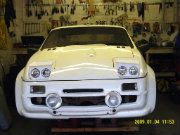Alan D. wrote:
The question being: does the compressed portion of the spring act as a load, do I need to exert 112.5 pounds (75 pound spring rate X 1.5 inches distance compressed = 112.5 pounds preload) of pressure before the spring deflects?
The answer is yes, the compression in the spring is the pre-load ~112.5lbs. The spring will not compress any further until the load acting on the top of the coil-over (corner weight) exceeds that figure.
This thread has prompted a few questions, so as I was in my workshop this afternoon I decided to take some measurements from the various springs and dampers that I could lay my hands on.
I didn't have the tools to measure any spring rates, but of the six springs that are either off cars being rebuilt or second hand ones from stock, the were all about 325mm - 12.75in long
A new GAZ adjustable damper, with adjustable spring seats, had a maximum spring height of 12 inches. So any of my stock springs would have to start with 3/4" of pre-compression.
An AVO adjustable with fixed spring seats also measured 12 inches between faces.
A Spax adjustable, again with fixed spring seats, measured 11 inches between faces. So that would start with 1 3/4" of pre-compression.
All three dampers measured 15.25 inches, when fully extended, from the bottom bolt centre to the top face of the mounting washer. With the mounting rubber in place this would become 15.5 inches.
I also measured the travel to the point of contact with the bump-stop:
The largest travel came from the AVO at 4 inches.
The GAZ damper had 3.5inches of travel. This had a longer bump-stop, which looked more progressive, so it probably allows another 1/4 inch or so of travel of gently restrained travel.
The SPAX damper had just 3 inches of travel and the bump-stop looked more solid and less progressive than the AVO.
I was also concerned to see that people have experienced corrosion quite early on with the GAZ dampers. When I next meet up with Dave from Dampertech I shall try to discuss this point. I can see that there will be a limit to how thick the plating can be when the body has to have a screw thread that allows the spring seat to move freely and the action of the seat being wound up and down could wear through the plating at its thinnest points. However, it should be possible to passivate it without affecting the tolerances and the passivation will also help protect against wear. Failing that it would be worth investigating a different plating method.


